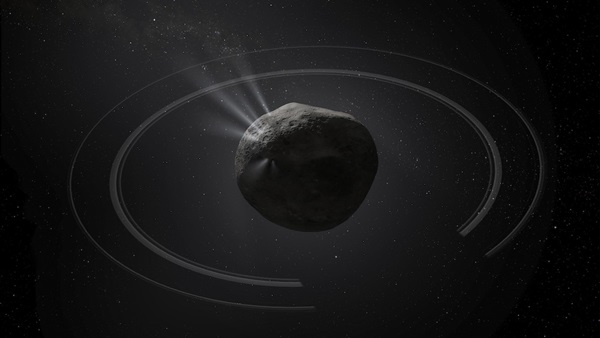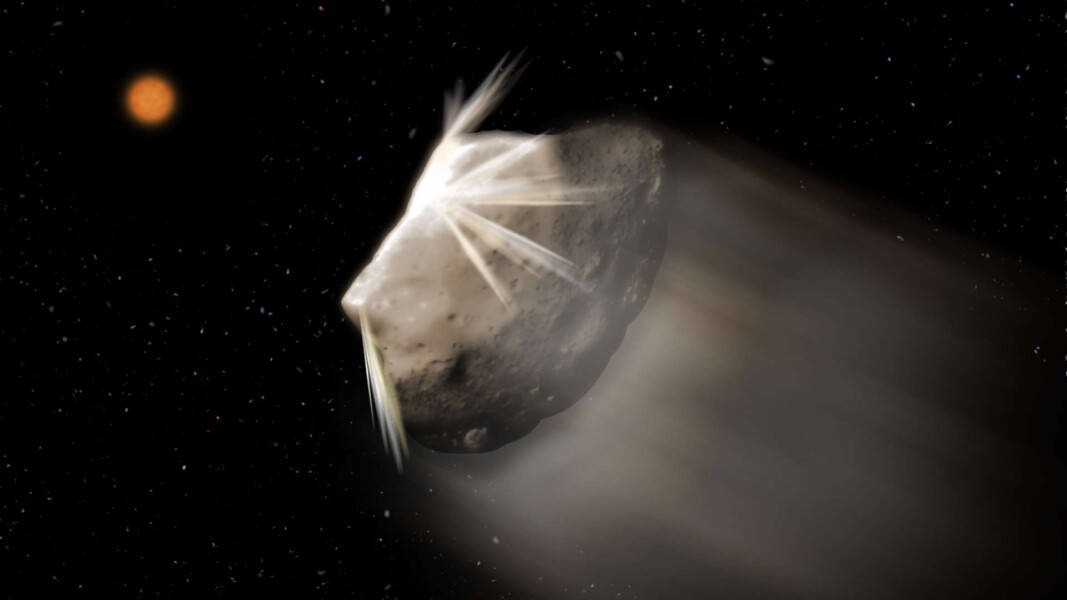
Objects that look like asteroids can still become active for numerous reasons. These objects are known as Centaurs and can have spots of activity and generate tails. Credit: Pamela L Gay/PSI.
In 1977, astronomer Charles Kowal discovered a strange, asteroid-like rocky object in the outer solar system. It was traveling slowly, as if orbiting the Sun beyond Neptune. This raised some eyebrows, as no asteroid had been discovered beyond Jupiter. Perhaps it was a comet that had lost its ices and was corralled into a more circular orbit by Saturn’s gravity. But no such objects had been discovered that far out, either, and this one was much larger than any known comet.
Kowal eventually named his discovery Chiron, after the wise centaur of Greek mythology, and suggested that the names of other centaurs be used for future similar objects.
What makes centaurs — half-human, half-horse — fitting namesakes is that these objects seem to straddle the line between asteroids and comets. Of the over 300 Centaurs known today, 39 have shown cometlike outbursts, sprouting a nebulous coma and sometimes a tail (including Chiron in the late 1980s and early 90s).
Scientists now know that these objects trickled inward from the frigid Kuiper Belt, the source of many of the solar system’s comets. But what causes only some Centaurs to display cometlike behavior is still unknown.
Now, a team of researchers led by Eva Lilly, a senior scientist at the Planetary Science Institute in Tucson, Arizona, have shown that all Centaurs observed with comae and tails have something in common: Each experienced recent changes to their orbits that Lilly and her colleagues call “jumps.”
The researchers discovered this while simulating the orbits of all known Centaurs over the past 5,000 years. In the model, the jumps happened when the objects had a close encounter with Saturn or Jupiter, which pulled them into more circular orbits, closer to the Sun. The work was published earlier this year in The Astrophysical Journal Letters.
A jump in understanding
The novelty of the new study is that the researchers calculated the orbits in more detail, with shorter time intervals between each step than in previous simulations. This allowed them to identify the orbital jumps, which in many cases would otherwise not have been noticeable.
“I thought something was going on with the dynamics,” says Lilly, “but I wasn’t expecting how very fast they would happen.”
The results show that the most recent jumps occurred less than 250 years ago and took between several months and several years to materialize. In most cases, the objects ended up orbiting closer to the Sun by tens of millions of miles — an inward jump of around half the distance between the Earth and the Sun.
“All of a sudden, they were placed in the warmest environments they have ever experienced in their lifetimes,” says Lilly.
To test whether the extra warmth from the Sun could penetrate Centaurs to reach ice beneath their surfaces, the team used a thermal model.
One Centaur, called P/2019 LD2 (ATLAS), warmed up by 36 degrees Fahrenheit (20 degrees Celsius) down to a depth of about 33 feet (10 meters) during a jump of about an Earth-Sun distance in early 2017. The results show that this would be enough to cause buried water ice to turn to vapor.

The heating of LD2 could also have heated amorphous water ice, a type of water ice unlike anything found on Earth that forms in the deep freezer of space. If this latter of ice is exposed to high enough temperatures, it will crystallize and suddenly release gases that could break off debris, quickly forming a cometlike atmosphere.
Interestingly, LD2 had a cometary outburst in 2017 that was detected by telescopes. But astronomers don’t know whether the activity had already begun prior to the jump.
‘A possible trigger for activity’
The uncertainty around LD2 highlights an ongoing issue that researchers have had in figuring out what sparks the activity of Centaurs: Despite sharing a common origin, each Centaur has unique properties, orbital changes and activity.
“It can be difficult to ignore the trees and see the forest,” says Teddy Kareta, a planetary astronomer at Lowell Observatory in Flagstaff, Arizona, who was not involved with the study.
Kareta says that what is really interesting about the new study is that by treating every Centaur the same way in their dynamical models, the team is able to focus on the population as a whole and pinpoint a possible trigger for activity.
The team also identified three Centaurs (SW223, 31824 Elatus, and 32532 Thereus) as targets for future surveys to check for cometary activity. These objects will reach their closest approaches to the Sun in about 15 years and the researchers’ simulations showed that they had recent jumps.
“We know a lot about how objects start and end,” says Kareta, “but we are really only starting to scratch the surface in understanding the middle where cometary activity first begins.”

